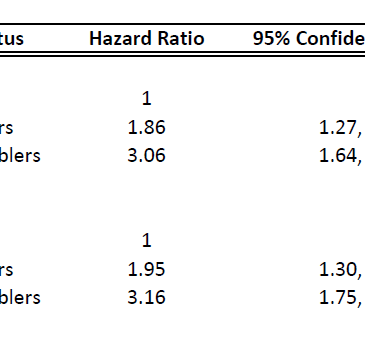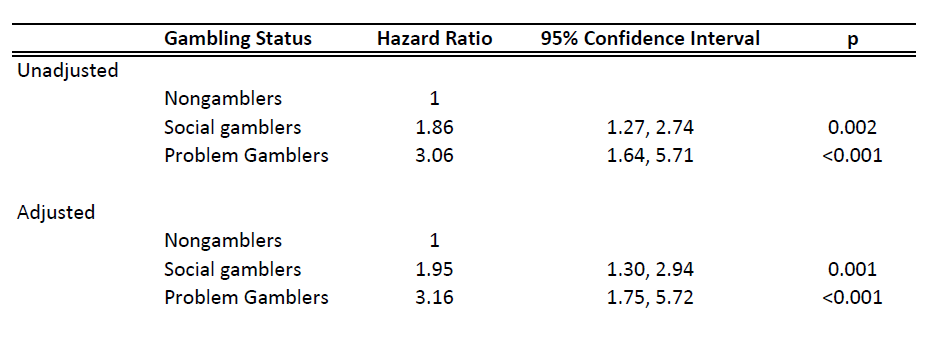Expanded gambling –such as today’s opening of the first casino in Massachusetts– raises many concerns about possible negative effects of gambling and gambling establishments. With this opening occurring in such close proximity to Father’s Day, it is natural to consider in which ways fatherhood and gambling might be related. Teen boys who gamble might also engage in other risky behaviors, including unprotected sex. This week, as part of our Special Series on Fatherhood and Addiction, The WAGER reviews a study that addresses risk for early fatherhood among teen boys who gamble (Lee, Storr, Ialongo, & Martins, 2013).
Methods
The authors used data from the Johns Hopkins Center for Prevention and Early Intervention Cohort 3 project (Ialongo, Poduska, Werthamer, & Kellam, 2001).
- Researchers recruited students from nine urban primary public schools in western Baltimore, MD during Fall 1993 (n = 678, 97% response rate, mean age = 6.2, 53% male).
- The cohort was followed up annually (80% retention rate through age 22).
- The original study assessed gambling behavior using the South Oaks Gambling Screen – Revised for Adolescents (Wiebe, Cox, & Mehmel, 2000).
- The researchers also assessed early conduct disorder, alcohol use, illegal drug use, parental monitoring, and high school dropout.
- Among male participants who provided data on fatherhood and gambling (n = 294), the researchers examined the relationship between gambling behavior and young fatherhood status.
- Young fatherhood was defined as having impregnated a sex partner by the age of 20.
- The researchers calculated hazard ratios to explore whether social or problem gamblers had higher risk of becoming young fathers than non-gamblers.
Results
- 41% of males in the sample reported fathering a child by the age 20.
- The study classified 35% of the sample as non-gamblers, 45% as social gamblers, and 19% as problem gamblers.
- Social gamblers and problem gamblers were 2 and 3 times more likely (respectively) than non-gamblers to be young fathers (Figure).
- This effect was stronger after controlling for covariates.
- Boys reporting having dropped out of high school and those receiving subsidized lunches were also more likely to be young fathers.
Figure. Hazard ratios for young fatherhood for social gamblers and problem gamblers (compared to non-gamblers). Adapted from Lee et al. (2013). Click image to enlarge.
Limitations
- The study’s small sample size limits its statistical power.
- Self-report data is subject to recall bias.
- Reliance on self-report pregnancy data means the researchers would miss any pregnancies not known to the father.
- The study design cannot assess whether a causal relationship exists, or the temporal sequence of young fatherhood and reported gambling behaviors.
- Additionally, gambling behavior could be a proxy for an assortment of risky behaviors which include unprotected sex. In which case the scope of the study is too narrow to elucidate this relationship.
Conclusions
Young fatherhood is a social issue associated with many adverse outcomes for fathers, mothers, and children (Jaffee, Caspi, Moffitt, Taylor, and Dickson 2001). Therefore, it is important to recognize which individuals are at an elevated risk for early fatherhood. This study identified several significant factors, such as social and problem gambling, subsidized lunch status, and high school dropout status, which were associated with an increased rate of young fatherhood. Many of these measures are associated with low socioeconomic status, which suggests that further research could identify people who could benefit from targeted prevention programs.
— Jed Jeng
What do you think? Please use the comment link below to provide feedback on this article.
References
Ialongo, N., Poduska, J., Werthamer, L., & Kellam, S. (2001). The distal impact of two first-grade preventive interventions on conduct problems and disorder in early adolescence. Journal of Emotional and behavioral disorders, 9(3), 146-160.
Jaffee, S. R., Caspi, A., Moffitt, T. E., Taylor, A., & Dickson, N. (2001). Predicting early fatherhood and whether young fathers live with their children: Prospective findings and policy reconsiderations. Journal of Child Psychology and Psychiatry, 42(06), 803-815.
Lee, G. P., Storr, C. L., Ialongo, N. S., & Martins, S. S. (2013). Does Adolescent Gambling Co‐occur with Young Fatherhood?. The American Journal on Addictions, 22(4), 417-424.
Wiebe, J. M., Cox, B. J., & Mehmel, B. G. (2000). The South Oaks Gambling Screen Revised for Adolescents (SOGS-RA): further psychometric findings from a community sample. Journal of Gambling Studies / Co-Sponsored by the National Council on Problem Gambling and Institute for the Study of Gambling and Commercial Gaming, 16(2-3), 275–288.





